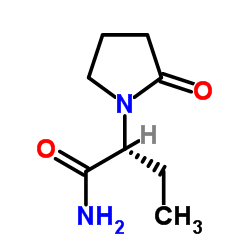Etiracetam

Etiracetam structure
|
Common Name | Etiracetam | ||
|---|---|---|---|---|
| CAS Number | 103765-01-1 | Molecular Weight | 170.209 | |
| Density | 1.2±0.1 g/cm3 | Boiling Point | 395.9±25.0 °C at 760 mmHg | |
| Molecular Formula | C8H14N2O2 | Melting Point | N/A | |
| MSDS | N/A | Flash Point | 193.2±23.2 °C | |
|
Inhibition of excitatory synaptic transmission in hippocampal neurons by levetiracetam involves Zn²⁺-dependent GABA type A receptor-mediated presynaptic modulation.
J. Pharmacol. Exp. Ther. 348(2) , 246-59, (2014) Levetiracetam (LEV) is an antiepileptic drug with a unique but as yet not fully resolved mechanism of action. Therefore, by use of a simplified rat-isolated nerve-bouton preparation, we have investigated how LEV modulates glutamatergic transmission from mossy... |
|
|
Efficacy and safety of pregabalin versus levetiracetam as adjunctive therapy in patients with partial seizures: a randomized, double-blind, noninferiority trial.
Epilepsia 55(7) , 1048-57, (2014) To assess the comparative efficacy and safety of pregabalin and levetiracetam for the reduction of seizure frequency in patients with partial seizures.This was a randomized, double-blind, flexible-dose, parallel-group noninferiority study of pregabalin and le... |
|
|
[Epilepsy in the elderly].
Tidsskr. Nor. Laegeforen. 133(5) , 528-31, (2013) Diagnostic work-up and treatment of patients who have developed epilepsy after the age of 65 can both be difficult. Epilepsy is one of the most common neurological conditions in the elderly, and the incidence of de novo geriatric epilepsy is rising. The aim o... |
|
|
Levetiracetam add-on therapy in Japanese patients with refractory partial epilepsy.
Epileptic Disord. 15(2) , 132-41, (2013) The aim of this observational study was to obtain information regarding efficacy and safety of add-on levetiracetam (LEV; n=32) in Japanese patients with refractory partial seizures in an everyday clinical setting, relative to control AEDs (n=30). This is the... |
|
|
Effect of switching hepatic enzyme-inducer antiepileptic drug to levetiracetam on bone mineral density, 25 hydroxyvitamin D, and parathyroid hormone in young adult patients with epilepsy.
Epilepsia 54(6) , e94-8, (2013) We sought to determine the effect of changing phenytoin therapy on bone mineral density (BMD) and 25-hydroxyvitamin D in patients with epilepsy. Of the 90 patients, 54 patients had switched to levetiracetam, 19 patients had stopped, and 17 patients continued ... |
|
|
Bayesian adaptive trials offer advantages in comparative effectiveness trials: an example in status epilepticus.
J. Clin. Epidemiol. 66(8 Suppl) , S130-7, (2013) We present a novel Bayesian adaptive comparative effectiveness trial comparing three treatments for status epilepticus that uses adaptive randomization with potential early stopping.The trial will enroll 720 unique patients in emergency departments and uses a... |
|
|
A prospective multicenter comparison of levetiracetam versus phenytoin for early posttraumatic seizure prophylaxis.
J. Trauma Acute Care Surg. 74(3) , 766-71; discussion 771-3, (2013) Brain Trauma Foundation guidelines recommend seizure prophylaxis for preventing early posttraumatic seizure (PTS). Phenytoin (PHE) is commonly used. Despite a paucity of data in traumatic brain injury, levetiracetam (LEV) has been introduced as a potential re... |
|
|
The established status epilepticus trial 2013.
Epilepsia 54 Suppl 6 , 89-92, (2013) Benzodiazepine-refractory status epilepticus (established status epilepticus, ESE) is a relatively common emergency condition with several widely used treatments. There are no controlled, randomized, blinded clinical trials to compare the efficacy and tolerab... |
|
|
Phenytoin or levetiracetam for seizure prophylaxis in TBI.
JAAPA 25(12) , 11, (2012)
|
|
|
Pharmacological and neuroethological studies of three antiepileptic drugs in the Genetic Audiogenic Seizure Hamster (GASH:Sal).
Epilepsy Behav. 28(3) , 413-25, (2013) Epilepsy modeling is essential for understanding the basic mechanisms of the epileptic process. The Genetic Audiogenic Seizure Hamster (GASH:Sal) exhibits generalized tonic-clonic seizures of genetic origin in response to sound stimulation and is currently be... |